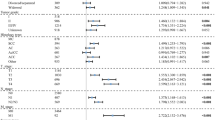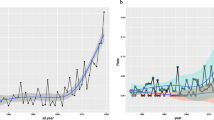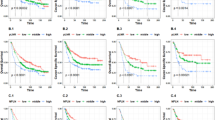Abstract
Background
While the accurate prediction of the overall survival (OS) in patients with submandibular gland cancer (SGC) is paramount for informed therapeutic planning, the development of reliable survival prediction models has been hindered by the rarity of SGC cases. The purpose of this study is to identify key prognostic factors for OS in SGC patients using a large database and construct decision tree models to aid the prediction of survival probabilities in 12, 24, 60 and 120 months.
Materials and methods
We performed a retrospective cohort study using the Surveillance, Epidemiology and End Result (SEER) program. Demographic and peri-operative predictor variables were identified. The outcome variables overall survival at 12-, 24-, 60, and 120 months. The C5.0 algorithm was utilized to establish the dichotomous decision tree models, with the depth of tree limited within 4 layers. To evaluate the performances of the novel models, the receiver operator characteristic (ROC) curves were generated, and the metrics such as accuracy rate, and area under ROC curve (AUC) were calculated.
Results
A total of 1,705, 1,666, 1,543, and 1,413 SGC patients with a follow up of 12, 24, 60 and 120 months and exact survival status were identified from the SEER database. Predictor variables of age, sex, surgery, radiation, chemotherapy, tumor histology, summary stage, metastasis to distant lymph node, and marital status exerted substantial influence on overall survival. Decision tree models were then developed, incorporating these vital prognostic indicators. Favorable consistency was presented between the predicted and actual survival statuses. For the training dataset, the accuracy rates for the 12-, 24-, 60- and 120-month survival models were 0.866, 0.767, 0.737 and 0.797. Correspondingly, the AUC values were 0.841, 0.756, 0.725, and 0.774 for the same time points.
Conclusions
Based on the most important predictor variables identified using the large, SEER database, decision tree models were established that predict OS of SGC patients. The models offer a more exhaustive evaluation of mortality risk and may lead to more personalized treatment strategies.






Similar content being viewed by others
Data availability
The datasets used and/or analyzed during the current study are available from the corresponding author on reasonable request.
References
Boukheris H, Curtis RE, Land CE, Dores GM (2009) Incidence of carcinoma of the major salivary glands according to the WHO classification, 1992 to 2006: a population-based study in the United States. Cancer Epidemiol Biomarkers Prev 18:2899–2906. https://doi.org/10.1158/1055-9965.EPI-09-0638
Guntinas-Lichius O, Wendt T, Buentzel J et al (2010) Head and neck cancer in Germany: a site-specific analysis of survival of the thuringian cancer registration database. J Cancer Res Clin Oncol 136:55–63. https://doi.org/10.1007/s00432-009-0636-y
Ellis GL, Auclair PL, Gnepp DR (1991) Surgical pathology of the salivary glands. Major problems in pathology. Vol. 25. Philadelphia: Saunders
Pinkston JA, Cole P (1999) Incidence rates of salivary gland tumors: results from a population-based study. Otolaryngol Head Neck Surg 120:834–840. https://doi.org/10.1016/s0194-5998(99)70323-2
Westergaard-Nielsen M, Godballe C, Eriksen JG et al (2021) Salivary gland carcinoma in Denmark: a national update and follow-up on incidence, histology, and outcome. Eur Arch Otorhinolaryngol 278(4):1179–1188. https://doi.org/10.1007/s00405-020-06205-2
Wahlberg P, Anderson H, Biörklund A, Möller T, Perfekt R (2002) Carcinoma of the parotid and submandibular glands–a study of survival in 2465 patients. Oral Oncol 38(7):706–713. https://doi.org/10.1016/s1368-8375(02)00007-6
Bell RB, Dierks EJ, Homer L, Potter BE (2005) Management and outcome of patients with malignant salivary gland tumors. J Oral Maxillofac Surg 63(7):917–928. https://doi.org/10.1016/j.joms.2005.03.006
Barnes L, Eveson JW, Reichart P, Sidransky D (2005) World Health Organization classification of tumours; pathology and genetics of head and neck tumours. IARC, Lyon, pp 209–215
Bhattacharyya N (2004) Survival and prognosis for cancer of the submandibular gland. J Oral Maxillofac Surg 62:427–430. https://doi.org/10.1016/j.joms.2003.06.012
Westergaard-Nielsen M, Godballe C, Eriksen JG et al (2023) Epidemiology, outcomes, and prognostic factors in submandibular gland carcinomas: a national DAHANCA study. Eur Arch Otorhinolaryngol 280:3405–3413. https://doi.org/10.1007/s00405-023-07940-y
Kaszuba SM, Zafereo ME, Rosenthal DI, El-Naggar AK, Weber RS (2007) Efect of initial treatment on disease outcome for patients with submandibular gland carcinoma. Arch Otolaryngol Head Neck Surg 133:546–550. https://doi.org/10.1001/archotol.133.6.546
Green B, Rahimi S, Brennan PA (2016) Salivary gland malignancies - an update on current management for oral healthcare practitioners. Oral Dis 22:735–739. https://doi.org/10.1111/odi.12498
Yamada K, Honda K, Tamaki H et al (2018) Survival in patients with submandibular gland carcinoma - results of a multi-institutional retrospective study. Auris Nasus Larynx 45:1066–1072. https://doi.org/10.1016/j.anl.2018.01.011
Şahin MM, Demircan V, Göcek M, Uzunoğlu E, Akmansu M, Sayar E, Kızıl Y, Aydil U (2020) Submandibular gland cancers: prognostic factors and survival analysis. Eur Arch Otorhinolaryngol 277:2307–2313. https://doi.org/10.1007/s00405-020-05924-w
Che WQ, Li YJ, Tsang CK et al (2023) How to use the Surveillance, Epidemiology, and end results (SEER) data: research design and methodology. Mil Med Res 10:50. https://doi.org/10.1186/s40779-023-00488-2
Lloyd S, Park HS, Decker RH, Wilson LD, Yu JB (2012) Using the Surveillance, Epidemiology, and end results database to investigate rare cancers, second malignancies, and trends in epidemiology, treatment, and outcomes. Curr Probl Cancer 36:191–199. https://doi.org/10.1016/j.currproblcancer.2012.03.008
Ellis MA, Gerry DR, Byrd JK (2016) Head and neck chondrosarcomas: analysis of the Surveillance, Epidemiology, and end results database. Head Neck 38:1359–1366. https://doi.org/10.1002/hed.24434
Song YY, Lu Y (2015) Decision tree methods: applications for classification and prediction. Shanghai Arch Psychiatry 27:130–135. https://doi.org/10.11919/j.issn.1002-0829.215044
Liu CY, Cheng CY, Yang SY, Chai JW, Chen WH, Chang PY (2023) Mortality evaluation and life expectancy prediction of patients with hepatocellular carcinoma with data mining. Healthc (Basel) 11:925. https://doi.org/10.3390/healthcare11060925
Collins GS, Reitsma JB, Altman DG, Moons KG (2015) Transparent reporting of a multivariable prediction model for individual prognosis or diagnosis (TRIPOD): the TRIPOD statement. Ann Intern Med 162:55–63. https://doi.org/10.7326/m14-0697
Brajkovic D, Kiralj A, Mijatov I, Ilic M (2023) Pathological nodal status as a main predictive factor of survival and treatment outcomes of submandibular salivary gland cancers: a 25-year single center experience. J Stomatol Oral Maxillofac Surg 124:101462. https://doi.org/10.1016/j.jormas.2023.101462
Lee RJ, Tan AP, Tong EL, Satyadev N, Christensen RE (2015) Epidemiology, prognostic factors, and treatment of malignant submandibular gland tumors: a population-based cohort analysis. JAMA Otolaryngol Head Neck Surg 141:905–912. https://doi.org/10.1001/jamaoto.2015.1745
Liu S, Xu W, Liu L, Zhu Y, Wu Y, Lu H, Yang W, Zhang C (2023) Prognostic factors and treatment considerations of submandibular gland carcinomas: a population-based study. Oral Dis 29:3298–3305. https://doi.org/10.1111/odi.14313
Liu S, Yang J, Lu H, Wu Y, Yang W, Xu W, Zhang C (2022) Adenoid cystic carcinoma of submandibular gland: emphasis on locoregional metastasis and prognosis. Oral Dis. https://doi.org/10.1111/odi.14478
Liu Y, Qin L, Zhuang R, Huang X, Su M, Han Z (2018) Nodal stage: is it a prognostic factor for submandibular gland cancer? J Oral Maxillofac Surg 76:1794–1799. https://doi.org/10.1016/j.joms.2017.11.012
Terhaard CH, Lubsen H, Van der Tweel I et al (2004) Salivary gland carcinoma: independent prognostic factors for locoregional control, distant metastases, and overall survival: results of the Dutch head and neck oncology cooperative group. Head Neck 26(8):681–693. https://doi.org/10.1002/hed.10400
Ellington CL, Goodman M, Kono SA et al (2012) Adenoid cystic carcinoma of the head and neck: Incidence and survival trends based on 1973–2007 Surveillance, Epidemiology, and End Results data [published correction appears in Cancer. 2012;118(21):5448-9]. Cancer 118(18):4444–4451. https://doi.org/10.1002/cncr.27408
Tian Z, Li L, Wang L, Hu Y, Li J (2010) Salivary gland neoplasms in oral and maxillofacial regions: a 23-year retrospective study of 6982 cases in an eastern Chinese population. Int J Oral Maxillofac Surg 39(3):235–242. https://doi.org/10.1016/j.ijom.2009.10.016
Liao WC, Chih-Chao C, Ma H, Hsu CY (2020) Salivary gland tumors: a clinicopathologic analysis from taipei veterans general hospital. Ann Plast Surg 84(1S Suppl 1):S26–S33. https://doi.org/10.1097/SAP.0000000000002178
Amini A, Waxweiler TV, Brower JV et al (2016) Association of adjuvant chemoradiotherapy vs radiotherapy alone with survival in patients with resected major salivary gland carcinoma: data from the national cancer data base. JAMA Otolaryngol Head Neck Surg 142(11):1100–1110. https://doi.org/10.1001/jamaoto.2016.2168
Nam SJ, Roh JL, Cho KJ, Choi SH, Nam SY, Kim SY (2016) Risk factors and survival associated with distant metastasis in patients with carcinoma of the salivary gland. Ann Surg Oncol 23(13):4376–4383. https://doi.org/10.1245/s10434-016-5356-3
Mallik S, Agarwal J, Gupta T et al (2010) Prognostic factors and outcome analysis of submandibular gland cancer: a clinical audit. J Oral Maxillofac Surg 68:2104–2110. https://doi.org/10.1016/j.joms.2009.09.030
Yang XG, Wang F, Feng JT, Hu YC, Lun DX, Hua KC, Liu YH, Zhang H, Yang L (2019) Recursive partitioning analysis (RPA) of prognostic factors for overall survival in patients with spinal metastasis: a new system for stratified treatment. World Neurosurg 127:e124–e131. https://doi.org/10.1016/j.wneu.2019.02.183
Guo C, Pan J, Tian S, Gao Y (2023) Using machine learning algorithms to predict 28-day mortality in critically ill elderly patients with colorectal cancer. J Int Med Res 51:3000605231198725. https://doi.org/10.1177/03000605231198725
Acknowledgements
Not applicable.
Funding
This work was supported by grant from the Science and Technology Plan Project of Guizhou Province (No. Qiankehe Foundation - ZK[2023] General 537), Zunyi Science and Technology Plan Project (No.Zunshi Kehe HZ Zi (2022) 387) and Zunyi medical college graduate student scientific research funds (No.ZYK202 and No.ZYK259). The sponsor or funder had no involvement in any part of this study. All authors confirmed the independence of researchers from funding sources.
Author information
Authors and Affiliations
Contributions
SSY and XGY: methodology, validation, formal analysis, investigation, data curation, writing-original draft, writing-reviewing and editing, and project administration. XGY: investigation, and data processing. SSY and XHH: validation, writing-reviewing and editing. XHY: project administration. All authors read and approved the final manuscript.
Corresponding authors
Ethics declarations
Institutional review board statement
The study was conducted in accordance with the Declaration of Helsinki, and the use of de-identified data from the SEER database exempted the study from requiring informed consent.
Competing interests
The authors declare no competing interests.
Additional information
Publisher’s Note
Springer Nature remains neutral with regard to jurisdictional claims in published maps and institutional affiliations.
Rights and permissions
Springer Nature or its licensor (e.g. a society or other partner) holds exclusive rights to this article under a publishing agreement with the author(s) or other rightsholder(s); author self-archiving of the accepted manuscript version of this article is solely governed by the terms of such publishing agreement and applicable law.
About this article
Cite this article
Yang, Ss., Yang, Xg., Hu, Xh. et al. Novel decision tree models predict the overall survival of patients with submandibular gland cancer. Clin Oral Invest 28, 395 (2024). https://doi.org/10.1007/s00784-024-05703-5
Received:
Accepted:
Published:
DOI: https://doi.org/10.1007/s00784-024-05703-5




